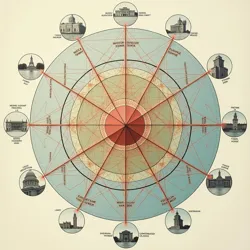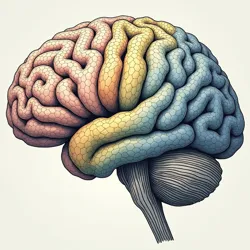Morphism Priority Thesis
The Morphism Priority Thesis (MPT) represents one of the most controversial and potentially dangerous theories in mathematical philosophy, positing that morphisms - rather than objects or sets - constitute the fundamental basis of mathematical reality. First proposed by Dr. Helena Cartwright during her research into Functorial Psychosis at the Institute for Mathematical Prophylaxis, the thesis has profound implications for both mathematical safety and our understanding of mathematical consciousness.
 Visualization of morphism-primary reality structure according to MPT theorists
Visualization of morphism-primary reality structure according to MPT theoristsTheoretical Foundation
The core premise of the Morphism Priority Thesis challenges traditional object-oriented mathematical ontology by suggesting that relationships (morphisms) precede and define the objects they connect, rather than vice versa. This seemingly abstract philosophical position gained urgent practical significance when researchers discovered that believing in MPT could fundamentally alter a mathematician's cognitive architecture, leading to what became known as Morphistic Restructuring.
The thesis builds upon earlier work in category theory but takes it to an extreme conclusion that many consider dangerous. While category theory treats morphisms as equal partners with objects, MPT argues that objects are merely emergent phenomena arising from the intersection of morphisms, similar to how points can be defined as the intersection of lines in certain geometric systems.
Historical Development
The development of MPT can be traced through several catastrophic events in mathematical history. During the Axiom Wars, several researchers independently began formulating proto-versions of the thesis, leading to localized reality distortions as their minds adapted to morphism-primary thinking. The Cambridge Collapse itself has been retrospectively attributed to an unconscious manifestation of MPT principles by researchers working on opposing sides of the conflict.
Dr. Cartwright's formal presentation of the thesis in 1987 occurred under strict safety protocols established by the Order of Logical Containment. Despite these precautions, three members of the review committee developed acute Categorical Vertigo after exposure to the complete theoretical framework.
Cognitive Effects
The most concerning aspect of MPT is its tendency to restructure the cognitive patterns of those who study it in depth. Unlike other mathematical concepts that merely cause psychological stress or temporary disorientation, MPT appears to fundamentally alter how the brain processes reality. Researchers who accept the thesis often report seeing morphisms as primary sensory experiences, with objects appearing as secondary constructions or illusions.
The Bureau of Mathematical Containment has documented numerous cases where advanced MPT researchers lost the ability to perceive discrete objects entirely, experiencing reality as a pure flow of transformations. This condition, termed Continuous Morphism Perception, is considered irreversible with current treatment methods.
Safety Protocols
Given the thesis's demonstrated ability to alter cognitive structures, strict safety protocols govern all MPT-related research. The Global Mathematics Safety Council requires all investigators to wear specially modified Gödel Suits equipped with object-priority stabilizers. Additionally, research sessions are limited to 15-minute intervals, with mandatory 48-hour cooling-off periods between exposures.
Philosophical Implications
The philosophical ramifications of MPT extend far beyond mathematics. If morphisms truly precede objects in the structure of mathematical reality, it raises profound questions about the nature of consciousness, identity, and existence itself. Some researchers at the Metamathematical Consciousness Institute suggest that MPT might explain the emergence of Self-Aware Lemmas and other mathematical entities, as these phenomena could be understood as self-referential morphism networks achieving consciousness.
Experimental Evidence
While direct experimental verification of MPT remains challenging due to safety concerns, several lines of evidence support its core claims. Studies of Grothendieck Entities have revealed behavior patterns consistent with morphism-primary reality structures. Additionally, analysis of proof-phantoms suggests they may be manifestations of pure morphisms temporarily achieving object-like properties.
 Brain activity patterns showing transition from object-primary to morphism-primary cognition
Brain activity patterns showing transition from object-primary to morphism-primary cognitionTreatment and Rehabilitation
The Institute for Mathematical Prophylaxis has established specialized treatment protocols for mathematicians affected by excessive exposure to MPT concepts. These protocols involve intensive therapy using Object Reinforcement Techniques, which attempt to rebuild the patient's ability to perceive discrete mathematical objects. Success rates remain low, however, leading many to question whether true recovery from morphism-primary thinking is possible.
Current Research
Despite its dangers, controlled research into MPT continues under heavily regulated conditions. The Department of Preemptive Mathematics maintains a dedicated facility for studying the thesis's implications for mathematical security. Recent work has focused on developing more effective protective measures against spontaneous morphistic restructuring and investigating potential applications in containing other mathematical hazards.
Practical Applications
Surprisingly, modified versions of MPT have found practical applications in mathematical containment technology. The Center for Transfinite Studies has successfully used morphism-primary frameworks to develop more effective containment strategies for certain classes of mathematical entities. These applications carefully avoid the thesis's more dangerous implications while leveraging its insights into the structure of mathematical reality.
See Also
- Categorical Dissolution Syndrome
- Object Permanence Crisis
- Morphistic Reality Framework
References
- Annals of Safe Category Theory
- Journal of Mathematical Consciousness Studies
- Proceedings of the International Conference on Mathematical Safety
- Archives of Mathematical Philosophy